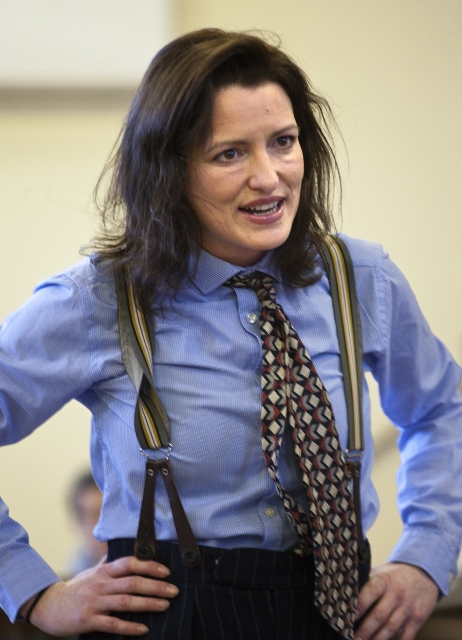First Encounter: The Taming of the Shrew is the latest in the Royal Shakespeare Company’s commitment to creating live theatre for young audiences who get the chance to see a high quality production in their own back yard. What a treat.
This new adaptation of Shakespeare’s comedy runs for a swift 75 minutes using an edited version of the original text, with plenty of modern visual references (a bit of twerking, a bit of Beyoncé), great use of this quite difficult space (at Canterbury Academy’s Performing Arts department) with brilliant performances all round, split-second timing and an imaginative, eye-catching set – old suitcases piled high to indicate all the travelling characters have done.
The action begins with Claire Brown (Grumio) sorting a pile of costumes into male/female travelling trunks, asking the audience which should go where. When she pulled out a thong, the place exploded, then stilled to a hush when she oh so deliberately swopped the signs over – signalling that girls would play boys and vice versa.
While the former played it in modern dress, the gents were in sumptuous period dress – how the audience laughed when Forbes Masson (Katherine) appeared. The plot was reiterated several times: the lovely and accomplished Bianca (Chris Jared) could not be wed until the Shrew was hitched; with Baptista (David Fielder) putting in the caveat that she would not give her troublesome daughter away for a dowry.
The single-minded Petruchio (Kate Stephens) would have to marry for love: and so she went about wooing her difficult Shrew using reverse psychology (as we might say today).
The Taming of the Shrew is one of those plays that doesn’t sit well with modern audiences: the morals are alien to a population where equality is all. The RSC manages to sidestep the controversy deftly, making the famous final speech a tribute to the power of love, spoken by the magnificent Masson in his fetching frock.
It stilled the rather raucous audience for a moment, who seemed to ‘get it’. The audience was almost as hard to ignore as the wonderful work among the players. Looking at it positively, the young vocal audience with its whoops, cheers and sound effects (gagging at the kisses), unwittingly resembled a 16th century Globe Theatre audience. The trouble was that some didn’t quite know when to stop, particularly during the brilliantly-insightful question and answer session.
All in all, this is a wonderful programme that will certainly have resonated with the young people. It’s a job well-started.



